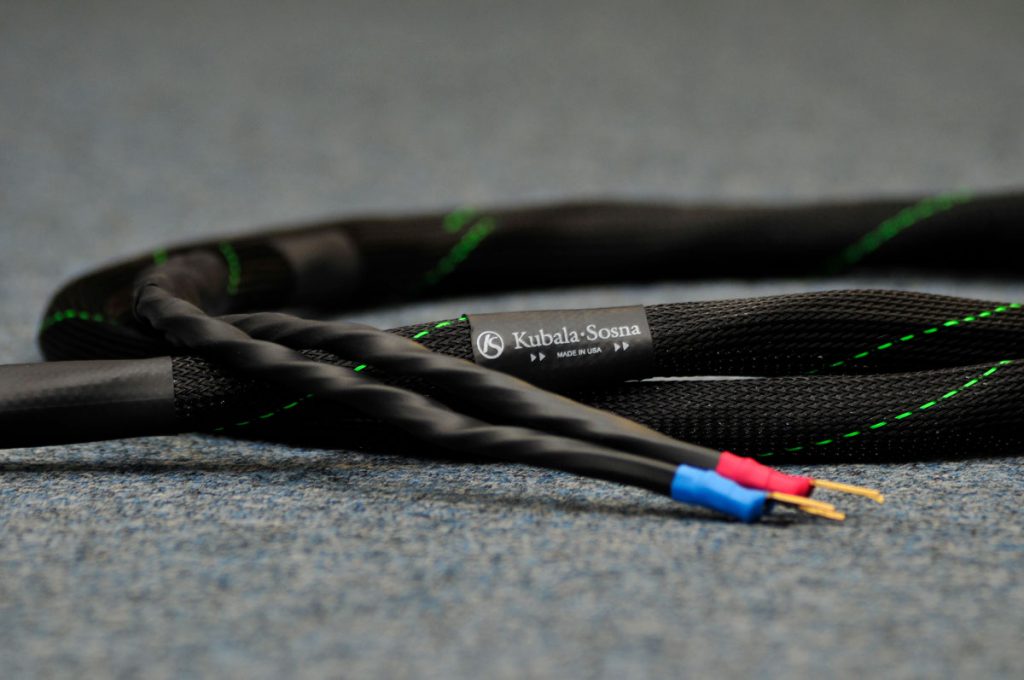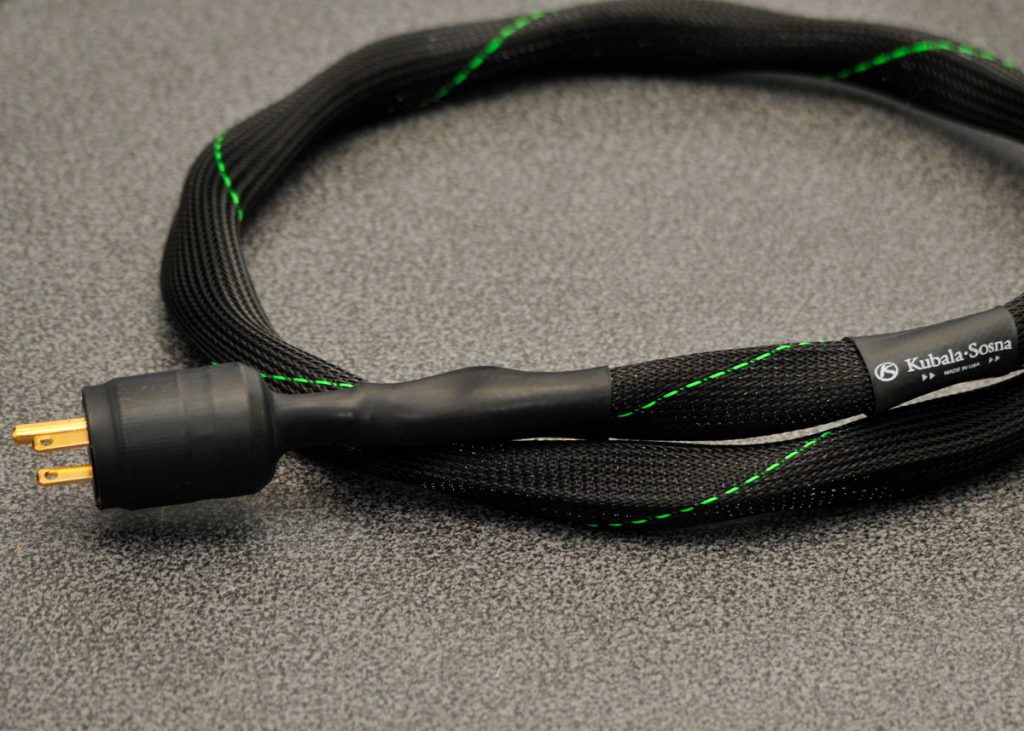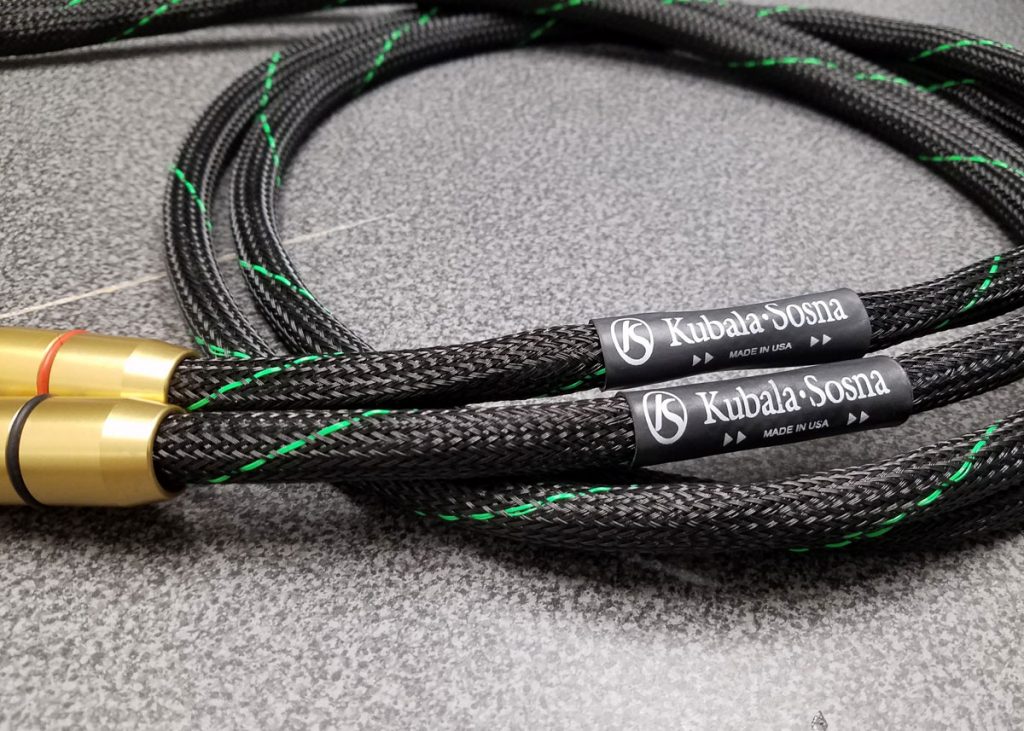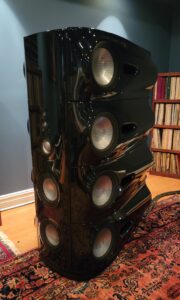The Unbearable Simplicity of Good Design
At the start of the summer, I waxed enthusiastic about the arrival of a boatload of new goodies that have made listening to music here at Casa Jeffries an unalloyed pleasure (HERE). Amongst the newcomers, the spectacular Kubala-Sosna Sensation cable loom really stood out. In my preview, I praised the Sensation loom's "eerie quietude, center of the earth bass reach, blinding transient precision, marmoreal dynamic clout, and class-leading tone and timbral precision" as defining features.
Unless you've been hiding from the Feds in a makeshift bunker over the past two decades, or simply checked out of the high-end universe altogether during the same timeframe, you will almost certainly have heard of Kubala-Sosna (K-S). At least as far back as the early 2000s, K-S has been disrupting the high-end audio cable pecking order. Defying conventional wisdom, the company took off right out of the gate. Propelled by the considerable design skills of Howard Sosna, a long-time audio consultant and entrepreneur, and the savvy business stewardship of Joe Kubala (who graciously shared with me K-S's core design priorities during an engaging one-hour phone call), the firm now surely ranks alongside Nordost, Audience, Stealth Audio Cables, MasterBuilt Audio, Crystal Cable, plus a handful of others as one of the world's premier purveyors of cables and power cords.
I first heard the K-S line of cables in 2013 at the then newly rebranded AXPONA audio expo in Chicago. At the time, it was common to encounter Veloce Audio's line of tubed and hybrid electronics paired with YG Acoustics speakers (particularly the tasty little Carmel) and a loom of K-S cables. On more than one occasion, I recall being wowed by the class-leading tone and timbral precision, transient quickness, and overall composure that the Veloce Audio / YG Acoustics / K-S suite delivered, at least under the kinds of listening conditions one routinely encounters at high-end audio shows.
Much, but certainly not all, of the quietude, bloom, speed, air, and life that I heard could be placed at the feet of the K-S cables. More recently, audiophiles and music lovers have been treated to world class show sound courtesy of the stellar YG Acoustics speakers, K-S wires, and the superb line of Audionet electronics, all represented by GTT Audio & Video.
Over the past decade, K-S has burnished its reputation as one of the leading high-end cable makers with a series of innovative and musically gratifying releases. The firm introduced the highly regarded Elation line in 2009 as the its flagship, with the Realization line following as the newer flagship series in 2017 (previewed HERE). The Sensation cables, also introduced in 2017, and the subjects of this review, are said to amalgamate the peerless neutrality and resolving power of the Realization line with the more richly balanced expressiveness of the Elation models.
Tellingly, and refreshingly so in my book, K-S eschews two practices commonplace in the High-End. First, K-S advertises very little. One will find the occasional corner or margin add on this or that web-based audio journal homepage, including here at Positive Feedback, but beyond that, nada (meaning also no full-page color spreads in any of the printed journals). Second, and this came as a bit of a surprise, K-S absolutely refuses to boast about the technical efficacy of their cables. While some firms throw at their customers any number of largely unsubstantiated technical claims about the superiority of their products, including the occasional science-laden, market-driven white paper, K-S instead asks potential purchasers to shop using the most important of marketing tools: their ears.
Like I said, to the point and unexpectedly refreshing.
Water-like Purity
This sound-quality-comes-first approach has clearly paid off (in my opinion). The moment I slipped the Sensations into my reference system (that system discussed in greater detail HERE), I knew I was in for a treat. Not wanting to alter too many sonic variables at once, I began by replacing my previous reference power cords with their Sensation counterparts. The changes I observed were neither subtle nor limited to a single qualitative musical parameter.
Sonically, the K-S loom excels in four musically important categories: overall quietude or what I call "stillness," tone and timbre (the latter pronounced tam•br as I was recently reminded), low end extension and tautness, and dynamic clout. The first quality, quietude or stillness, is one frequently discussed in audio reviews, but usually under the "black background" misnomer. Conceptually, I understand, at least in part, what other reviewers mean when they use (far too liberally, in my opinion) the "black background" descriptor. On occasion I have used it myself. Simply stated, colors, hues, and textures appear to the eye, or to the ear in audio terms, as more vivid, lifelike, and palpable when portrayed against a black sonic background.
By the same token, those audio components—cables included—that effectively reduce (or eliminate) extraneous noises and electromagnetic distortions, will better enable tonal colors, vocal and instrumental textures, and associated ambient detailing to stand proud in the mix, as if projected from a silent (or inert) "black background." In short, reducing the bad stuff makes it easier for the listener to hear (and appreciate) all the good stuff embedded in the recording.
But (and this is extremely important to remember), all those distortions, noise artifacts, and related distractions are, like the music itself, fluid quantities, meaning fluid in time, frequency, phase, amplitude, etc. By extension, the descriptive language we use to qualify the absence of these distortions should, ideally, reflect the fluid sonic environments within which they manifest. To my way of thinking then, the more accurate descriptive analogy is not to "blackness" as the relative absence of color-robbing, tone-bleaching, dynamic-suppressing distortions (and all the "static" sonic implications that the term carries), but to stillness, as in still waters.
Let me elaborate with a real-world example. I live in Central Florida, a part of the country where mangroves, wetlands, lakes, small ponds, and Category 3 hurricanes are as commonplace as finger-sized lizards. On a clear day, if one stares at the assortment of rocks, pebbles, water flora and fauna that lie one or two feet off the shoreline of one of these shallow ponds, you will notice several things. In still conditions, you can easily discern all manner of textures, colors, and hues agitating beneath the pond surface: the whitish tint of small rocks and pebbles, the vibrant green pastels of underwater plant life and algae, the earthy reddish-brown pigmentation of decaying twigs and tree bark, and the silver-blue speckles of tiny minnows fluttering in the light-dappled pool.
However, drop a small stone into those waters and two visible phenomena will break the stillness: the detail-distorting ripples created after the stone breaks the water's surface, and the brownish plume of silt, sand, and mud that rises from the pond floor like liquid smoke, obscuring all that the sunlight had previously rendered clear and transparent. If you try hard, you can still make out all the macro-details you noticed before—the small rocks and pebbles, the underwater plant life and algae, the decaying twigs and bark strands, and the silver-blue minnows— but the micro-details, meaning all of the textures, hues, and tints, not to mention the light-to-dark shadowing that generate depth of field perspectives, will have vanished, all now distorted by the murky brown ardor of the discoloring silt, sand, and mud plume.
By removing grit, grime, and noise to sonically undetectable levels, the K-S loom delivers the same type (and degree) of detail-rendering stillness described above to the reproduction of music in the home listening environment, regardless of musical genre. To my ears, the Sensation cables gift this remarkable stillness first by suppressing RF and EMI distortions to a minimum, and second by preserving the delicate time and phase relationships that render electronically reproduced music more intelligible and coherent. In other words, the K-S loom effectively suppresses those quantities we don't want (noise and associated distortions) but preserves those quantities we do want (tone, timbre, air, dynamic flow, etc.), and to a degree that, if not unique, remains quite rare.
This means that in the listening room, music flows with unforced naturalness and liquidity, the cables simply doing what the best components should: add as little to the proceedings as possible. One of my favorites over the past couple of years, Polish trumpeter Tomaz Stanko's 1999 release From the Green Hill (ECM), demands a system that can lay bare (but not clinically) the intricate tonal shadings and delicate interplay of timbre and texture that makes this disc so musically engrossing. On the standout cut "Domino," the K-S loom allows every other component in the system to reproduce unambiguously baritone saxophonist John Surman's beefy, mercurial, Eastern infused musings, Dino Saluzzi's scrumptious-sounding bandoneon, the instrument literally dripping with the moist, tactile haze of a déjà vu-induced daydream, and lead trumpeter Stanko's sweet and sour back-and-forth bobbing and weaving.
Switch musical gears and you get more of the same. Tempted by the tropically scented lyricism of Tom Jobim's imminently hummable "Photograph," from Grammy award-winning saxophonist Joe Henderson's 1995 release Double Rainbow (Verve), the K-S-wired system commandingly captures the bitter-sweet bite of Henderson's muscular, overtone-rich tenor with class-leading repose and precision. Without ambiguity, one can both sense and hear the fluttering of moist air through Joe's preferred plastic mouthpiece, his delicate fingerings and the associated "plop" of leather key pads against the instrument's brass tone holes, and the billowing waves of moist air that bloom almost like liquid (there's that reference to water-like purity and flow again) out of the saxophone bell.
By the way, despite what some young students of the saxophone might believe, it is the internal architecture of a given mouthpiece, particularly the internal projection baffle, that largely determines whether a player's sound will seem bright or mellow, not the material used to create the mouthpiece itself.
The K-S cable loom also loves well-recorded vocals (especially in conjunction with the stellar Mola Mola electronics suite that I'll be writing about next month). The Sensation suite captures intact the raspy scratch, semi-sweet chocolate, and liquid flow of singer Melody Gardot's seductive voice, leaving in the ether only that last degree of saturated tone, timbre, and dynamic composure when compared to more expensive setups. On an intimately recorded disc like her 2009 release My One and Only Thrill (Verve), the sense of flowing liquidity, 3D palpability, and rich tone on display, along with the near class-leading texture and purity, sound positively otherworldly.
The Sound of Thunder
As I teased at the outset of this review, the K-S loom delivers in the nether regions like nothing else I've heard. I also hinted in my start-of-summer product preview (HERE) that the Mola-Mola suite, particularly the Kaluga mono block amps (class D devices all the way), deftly reproduce bass notes with near unparalleled impact, precision, and weight. This sense of unfettered bass power, reach, and unflappable control reached new heights when I inserted the K-S suite into the system, first the power cables, these followed by the interconnects and speaker cables.
Both analog and digital sources benefit from the Sensation loom's low-end authority. Good ole' vinyl's core musical strengths, namely forward musical momentum, transient precision, and micro-dynamic fluidity, are on full display here, as one would expect. What I did not expect was room-shaking bass. But that's just what I got when I inserted the lively JE Audio HP20 phono preamp I reviewed a while back (HERE) into a system that included the Sensation cables. While the K-S loom allowed the little HP20 to reproduce tonal shadings and instrumental timbres with impressive color, texture, and resolution, they also allowed the Hong Kong immigrant to punch with real authority down low.
On a beautifully mastered (remastered, actually) LP like Chad Kassem's stellar reissue of the Sibelius: Symphony No. 5 and Karelia Suite (RCA/Decca-Analogue Productions), the HP20 / K-S paring delivered near reference levels of low-end slam, punch, and control. Analogue Productions' RCA Living Stereo / Decca reissues have, in short order, garnered a well-deserved reputation for delivering the musical goods down low. The Sibelius disc is no exception. The HP20 / K-S loom captures(ed) all of Papa Jean's Scandinavian moodiness, plus nearly the full measure of bass wallop and slam, not to mention impressive tonal precision and tautness.
Typically, class-leading bass authority goes hand in hand with overall dynamic clout, and in this arena the K-S loom really struts its stuff. With large-scale works, the K-S suite retains its reference-caliber immediacy, but usefully adds massive doses of dynamic swagger, control, and musical scaling to the sonic mix. On recordings demanding this heightened degree of power, impact, and control, Bernstein's sensitive reading of Mahler's magisterial fourth, for example (Mahler: Symphony No. 4 in G Major [Sony / Columbia]), one has the real sense that you are sitting in a concert hall (or at least at the Manhattan Center recording studios where this performance was recorded), not a space-constrained listening room.
Sticking with Mahler, say, Claudio Abbado's delightful reading of Gustav's magisterial Symphony No. 9 (Deutsche Grammophon 0289-479-0561-5/CD), the K-S loom allows my reference Von Schweikert Unifield 2 Mk. III compacts to bump and grind with a level of dynamic swagger reserved for the very best compacts in the business. This superb dynamic scaling and deep bass thrust makes it easy to envision the sonic footprint of the Philharmonie (the name given the Berlin Philharmonic's tent-like modern home). With the K-S loom doing the driving, in addition to the sheer impact, grunt, and bass weight on offer, one really does get the sense of both hearing and feeling a living, breathing performance hall. The overall effect is quite startling, and extraordinarily lifelike.
Importantly, the K-S loom avoids the sonic bête noire that frequently bedevils some otherwise fine components, namely their inability to deliver great bass power, maximal dynamic expressiveness, and a natural tonal balance simultaneously. Good cables in good systems typically give you two of the above-noted qualities, but rarely all three. Cable A, for example, will deliver tremendous bass power and dynamic punch, but shortchange mid-bass naturalness, producing a sound that wears thin over time. Cable B will deliver great bass reach and mid-bass fullness, but harden on musical transients, leading to listener fatigue and a sense of dynamic compression. The Sensation loom delivers all three metrics admirably but does so by deftly balancing each to produce a genuinely satisfying and realistic musical whole.
Parting Thoughts
If you've followed closely what I've reported thus far, it should come as no big surprise that the K-S Sensation cable loom really hits all my audio buttons. They blend immaculate construction values with gorgeous sound quality to produce an enticing and intoxicating mix. They are, in high-end terms, priced quite fairly, but not cheaply, as one should expect. I have, on a few specific occasions, heard better overall sound from other cables in this or that discreet performance metric (the Stealth Indra in the air and ambience retrieval arena, and the MasterBuilts in terms of sheer dynamic clout, for example), but no cables that outright clobber the Sensations in overall musicality.
As such, they heartily deserve the rarified "sonic reference" designation afforded much more expensive products. At roughly $30 - 40K for a complete loom (or roughly one-tenth the price of the MasterBuilt loom exhibited at AXPONA 2019 in the Von Schweikert / VAC / Audio Company suite), they cost as much as an entry-level Tesla or Lexus, and sound at least as good as those cars look. In short, you really should give them a spin. You will not, I promise, regret doing so, even if their unique mix of musical strengths and your given sonic priorities don't mesh entirely.
If I could afford to buy the loom I reviewed, I'd do so in a heartbeat. They are that good.
Cheers!
Kubala-Sosna Research LLC Sensation Cables
Retail: RCA and XLR interconnects $5800m/$1200 each additional meter
Retail: Speaker cables $5800m/$1200 each additional meter
Retail: Digital cable (USB) $2200m/$600 each additional meter
Retail: Power cords: $1650m/$400 each additional meter
Kubala-Sosna Research LLC
11 Melanie Lane, Unit 24A
East Hanover, NJ 07936









































